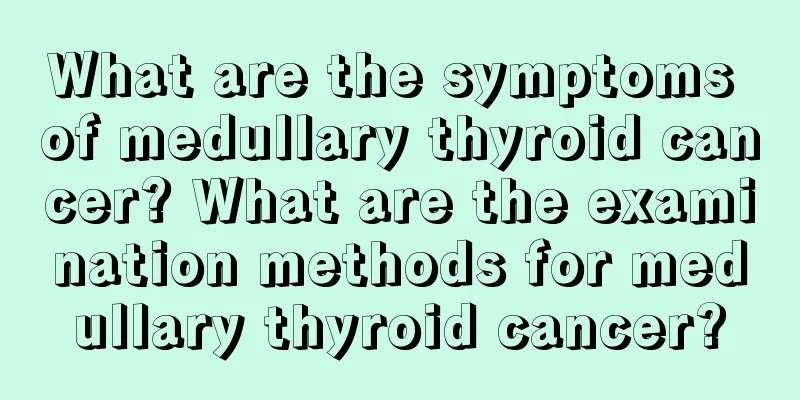What are the symptoms of medullary thyroid cancer? What are the examination methods for medullary thyroid cancer?

|
The main cause of medullary thyroid cancer is the mutation of the RET oncogene. When symptoms such as unilateral or bilateral thyroid masses, dyspnea, dysphagia, hoarseness, tetany, and carcinoid syndrome occur, one should be alert to the occurrence of medullary thyroid cancer. Women, people between the ages of 30 and 60, and those with a family history of thyroid, parathyroid, and adrenal tumors are susceptible to medullary thyroid cancer and should be careful to prevent it. Medullary thyroid cancer is not actually thyroid cancer. It originates from the thyroid parafollicular cells that secrete calcitonin. They are neuroendocrine cells and have nothing to do with thyroid follicular cells. Medullary thyroid cancer can be divided into two types: sporadic and hereditary. Hereditary medullary thyroid cancer occurs 10-20 years earlier than sporadic medullary thyroid cancer and is more common in males than in females. Hereditary medullary thyroid cancer is an autosomal dominant genetic disease. Patients with medullary thyroid cancer and their first-degree relatives are tested for the RET oncogene mutation gene. It is difficult to differentiate thyroid cancer from other thyroid cancers by color Doppler ultrasound examination alone. If the tumor is large, ultrasound-guided puncture examination is a highly sensitive means of diagnosis. If the preoperative calcitonin level is greater than 100 ng/L, it can basically be diagnosed as medullary thyroid cancer. If lung, liver or bone metastasis is suspected, relevant examinations such as lung CT or whole-body bone scan should be performed to make a diagnosis. Medullary thyroid cancer is insensitive to radiotherapy and chemotherapy. At the same time, the paracrine cells of the thyroid follicles do not absorb iodine. 131I radiotherapy is ineffective for medullary thyroid cancer. Medullary thyroid cancer may spread intraglandularly. The recurrence rate is low after total thyroidectomy. Therefore, regardless of whether it is sporadic or hereditary medullary thyroid cancer, the best surgical method is total thyroidectomy. There was no statistically significant difference in the effects of different initial symptoms, various stages, different surgical methods for primary lesions, neck lymph node dissection, whether the neck lymph nodes were metastatic, treatment methods, recurrence, and endocrine symptoms such as diarrhea on prognosis. |
Recommend
It is best for patients to detect the symptoms of ovarian cancer in time
According to surveys, ovarian cancer is a very co...
Is chemotherapy needed after thyroid cancer surgery? What should I pay attention to after thyroid cancer surgery?
In recent years, more and more people are sufferi...
What are the complications after maxillary cancer surgery
What are the complications after maxillary cancer...
What to do if you have insomnia
Nowadays, many people suffer from insomnia. This ...
How to determine whether there are roundworms
Some parents will be very worried when their chil...
What causes red eyes when having a fever
We found that many babies have red and swollen ey...
How to clean a yellowed sink?
With the development of the economy, the living s...
How to treat anal poditis
Anal sinusitis is a relatively common perianal di...
How to deal with a child's high fever and convulsions
When a child has pneumonia or a cold, it is easy ...
What are the treatment principles for liver cancer? Five principles are followed in treating liver cancer
The harmfulness of liver cancer cannot be ignored...
What are the secret recipes of traditional Chinese medicine for treating colon cancer
Traditional Chinese medicine treatment for colon ...
Lactate dehydrogenase assay method
We know that there are various enzymes in real li...
Take out something stuck in your teeth quickly
There are gaps between human teeth, so it is very...
Experts suggest how to prevent uterine cancer
Uterine cancer is the most common malignant tumor...
What are the symptoms of nasopharyngeal carcinoma? How should patients with stage 2 choose their diet?
What are the symptoms of nasopharyngeal cancer? W...









